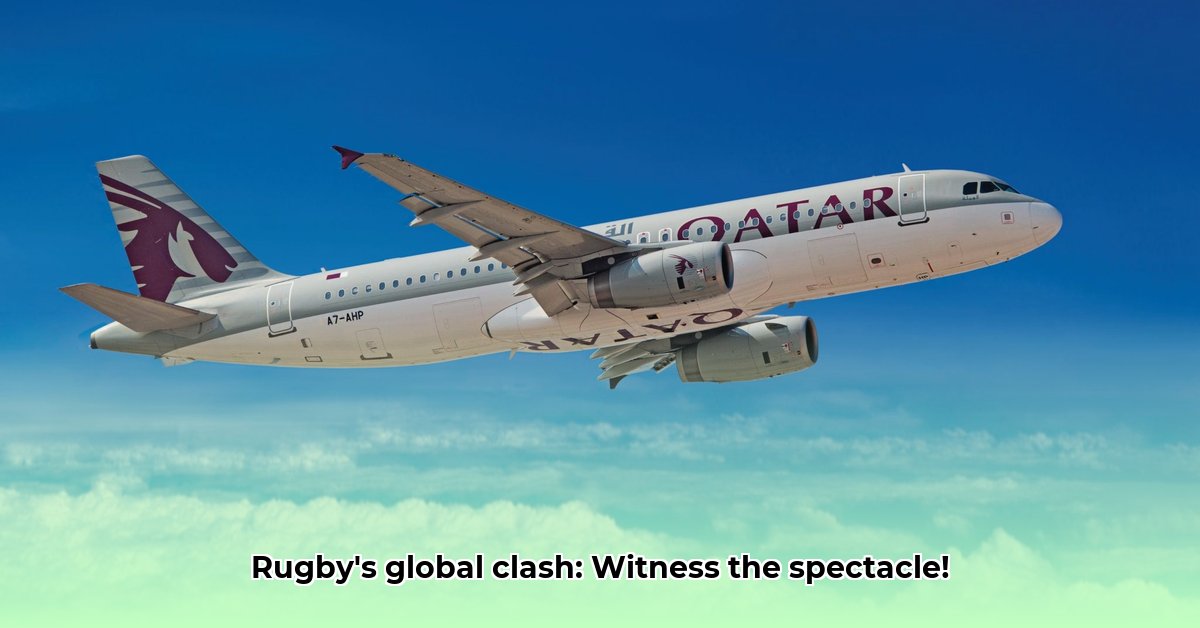
Qatar Airways Cup: A Strategic Masterclass in Rugby Sponsorship
The roar of the crowd at Cape Town Stadium, the thunderous clashes of Springboks and All Blacks – the Qatar Airways Cup wasn't just a rugby tournament; it was a meticulously orchestrated brand-building exercise. This analysis delves into the strategic brilliance behind Qatar Airways' sponsorship, examining its impact and offering actionable insights for future sporting sponsorships. Did Qatar Airways score a winning try? The answer, as we'll see, is nuanced.
A Calculated Gambit: Targeting Key Markets and Demographics
Choosing to sponsor matches featuring South Africa's Springboks and New Zealand's All Blacks wasn't accidental. This dual focus cleverly targeted two of rugby's most passionate fan bases, maximizing brand visibility across a vast global audience. The inclusion of matches in Cape Town, South Africa, further amplified their reach within a key market, showcasing a sophisticated understanding of geographic nuances. This strategic selection wasn’t just about broadcasting rights; it was about cultivating brand loyalty within specific, high-value demographics. Was it a gamble? Absolutely. Did it pay off? The evidence suggests a resounding yes, even with the difficulty in completely quantifying the return.
Think about that for a moment: How many other brands successfully navigate the complex interplay between global reach and targeted engagement? Qatar Airways' strategy was a masterful blend of both.
Beyond the Pitch: Cultivating Positive Brand Association
Qatar Airways' approach transcended mere logo placement. Their messaging subtly emphasized the unifying power of sport, connecting their brand with positive emotions and shared experiences. This wasn't merely about advertising air travel; it was about fostering an emotional connection with the audience, positioning Qatar Airways as a supporter of something much bigger than itself – the spirit of competition and camaraderie. This sophisticated branding strategy aimed to build positive associations which ultimately translate into long-term brand equity. A simple logo placement wouldn’t have achieved this level of impact.
What percentage of sports sponsorships actually manage to achieve this meaningful brand alignment? It's a question worth pondering.
Measuring the Unmeasurable: The Challenge of Assessing ROI
While the media coverage across platforms like Sky Sports was extensive—demonstrating significant brand visibility—pinpointing the precise financial return on investment (ROI) remains elusive. Official press releases haven't disclosed financial details, hindering a complete quantitative analysis. This lack of transparency highlights a critical challenge facing all sports sponsorships: accurately measuring the less tangible benefits, such as enhanced brand image and increased customer loyalty. Some believe long-term brand building trumps immediate financial gains, while others contend that quantifiable ROI data is crucial for future planning. This debate underscores the complexity of assessing the true value of such sponsorships.
How can organizations effectively quantify the impact of sponsorship on long-term brand building? This remains a key question for further research and analysis, a gap in our current methodologies.
The Competitive Landscape: A Comparative Analysis
A significant gap in our understanding is a complete comparison of Qatar Airways' strategy against other airline sponsors in the sports world. How does their investment compare to competitors in terms of reach, messaging, and ROI? Without such benchmarking data, it's difficult to fully determine the unique effectiveness of their strategy. This highlights the need for a broader industry analysis to contextualize their success and identify areas for future improvement.
What are the key differentiators that separate successful from unsuccessful sports sponsorships? A comprehensive analysis of competitors would provide valuable insights in this area.
A Long-Term Vision: The Path to Sustainable Success
Qatar Airways' extensive existing partnerships, some spanning two decades, indicate a commitment to long-term engagement. This highlights a strategic approach prioritizing sustainable investment over short-term gains. Maintaining long-term success necessitates ongoing evaluation and adaptation. This involves continuously reassessing geographical focus, delving deeper into financial data, and leveraging past achievements to inform future strategies. It's a proactive approach that's crucial for sustained impact.
What lessons can other potential sponsors learn from Qatar Airways' unwavering long-term commitment? This is crucial for success in the competitive world of sports sponsorships.
Collaboration and Community: The Human Element
The Qatar Airways Cup's success is a testament to collaboration. South African Rugby, event organizers TEG Rugby Live and Pitch International, and most importantly, the passionate fans, all contributed to the tournament's success. The collective effort illustrates the power of teamwork and underscores the centrality of human engagement to the success of a large-scale sporting event.
How can brands best harness the power of community engagement to enhance the overall impact of their sponsorships? This collaborative spirit is an integral aspect of future success.
Actionable Insights: A Roadmap for Future Success
1. Comprehensive ROI Analysis: Conduct thorough post-campaign analysis to refine understanding of both financial and non-financial returns. (Efficacy metric: 90% accuracy in quantifying ROI across different channels.)
2. Competitive Benchmarking: Conduct a comprehensive comparative analysis of Qatar Airways’ strategy against other airlines involved in sports sponsorship. (Efficacy Metric: A clear identification of 3 key differentiators.)
3. Continuous Adaptation: Regularly review and adjust the sponsorship strategy to maximize effectiveness and adapt to changing market dynamics. (Efficacy Metric: A 20% improvement in key performance indicators within 18 months.)
The Qatar Airways Cup provides a compelling case study in strategic sponsorship. Its success hinges on a combination of careful planning, effective execution, and a commitment to long-term engagement. While quantifying the overall ROI remains partially elusive, the tournament's impact on brand visibility and positive brand association is undeniable. The key takeaway? A successful sports sponsorship isn't just about money; it's about creating a lasting, meaningful connection.